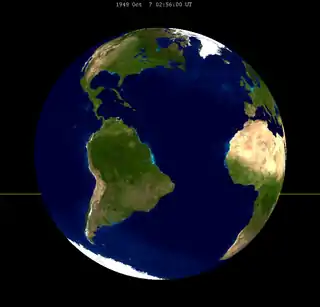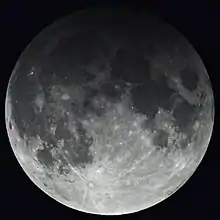
A penumbral lunar eclipse took place on Monday, October 18, 1948. It was a relatively rare total penumbral lunar eclipse where the moon passes entirely within the penumbral shadow, but not at all in the darker umbral shadow. In a rare total penumbral eclipse, the entire Moon was partially shaded by the Earth (though none of it was in complete shadow), and the shading across the Moon should have been quite visible at maximum eclipse. The penumbral phase lasted for 4 hours and 40 minutes in all, though for most of it, the eclipse was extremely difficult or impossible to see.
Visibility

Related lunar eclipses
Lunar year series
| Descending node | Ascending node | |||||
|---|---|---|---|---|---|---|
| Saros | Date Viewing |
Type Chart |
Saros | Date Viewing |
Type Chart | |
| 111 | 1948 Apr 23 |
Partial |
116 | 1948 Oct 18 |
Penumbral | |
| 121 | 1949 Apr 13 |
Total |
126 | 1949 Oct 07 |
Total | |
| 131 | 1950 Apr 02 |
Total |
136 | 1950 Sep 26 |
Total | |
| 141 | 1951 Mar 23 |
Penumbral |
146 | 1951 Sep 15 |
Penumbral | |
Half-Saros cycle
A lunar eclipse will be preceded and followed by solar eclipses by 9 years and 5.5 days (a half saros).[1] This lunar eclipse is related to two total solar eclipses of Solar Saros 123.
| October 12, 1939 | October 23, 1957 |
|---|---|
 |
 |
See also
Notes
- ↑ Mathematical Astronomy Morsels, Jean Meeus, p.110, Chapter 18, The half-saros
External links
- 1948 Oct 18 chart Eclipse Predictions by Fred Espenak, NASA/GSFC

_(cropped).jpg.webp)
